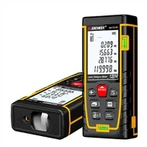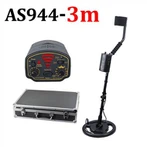How to use a multimeter to distinguish whether a transistor transistor is a silicon transistor or a germanium transistor?
The discrimination of a transistor can be determined by using a multimeter to determine its polarity, whether it is a silicon transistor or a germanium transistor, and to distinguish its pins at the same time. For general low-power transistors, it is generally only appropriate to use R for judgment × 1K gear. The steps are as follows:
(1) Forward and reverse testing:
Measure the resistance of any two pins of the transistor with a red and black probe, and then exchange the red and black probes to still measure the resistance of these two pins. If the resistance readings are different between the two measurements, the measurement with a smaller resistance reading is called a forward measurement, and the measurement with a larger resistance reading is called a reverse measurement.
(2) Determine the base:
Code the three pins of the transistor as 1, 2, and 3. The multimeter is used for three types of measurements, namely 1-2, 2-3, 3-1, each of which is further divided into forward and reverse measurements. Out of these six measurements, three were positive measurements and the resistance readings were different. Find the pin with the highest resistance being measured, such as 1-2, and the other pin 3 is the base. Due to the fact that semiconductor triodes are formed by connecting two diodes in reverse. The forward resistance between the emitter, collector, and base is generally the forward resistance of a diode, which is very small. When the two probes are connected to the collector and emitter, their resistance is much greater than the forward resistance of a typical diode.
(3) Polarity discrimination:
The black probe is connected to the determined base, and the red probe is connected to any other pole. If it is a positive measurement, it is an NPN tube, and if it is a reverse measurement, it is a PNP tube. This is because the black lead is connected to the positive terminal of the battery inside the multimeter. If it is a positive test, the black lead is connected to the P terminal, and the transistor is of NPN type. For reverse testing, the black probe is connected to the N-terminal, and the transistor is of PNP type.
(4) Determine collector and emitter:
Perform a positive test on the base electrode. For NPN tubes, the black probe is connected to the collector electrode, and for PNP tubes, the black probe is connected to the emitter electrode. This is because regardless of forward or reverse testing, there is a PN junction in the opposite direction, and most of the battery voltage drops on the opposite PN junction. The forward bias of the emission junction and the reverse bias of the collector circuit result in a larger current flow and a smaller resistance. So, for NPN tubes, when the resistance between the collector and emitter is low, the collector is connected to the positive electrode of the battery, that is, to a black probe. For PNP tubes, when the resistance between the collector and emitter is low, the emitter is connected to a black probe.
(5) Distinguishing whether it is a silicon tube or a germanium tube:
Perform forward testing on the emitter base, and if the pointer deviates by 1/2 to 3/5, it is a silicon tube. If the pointer deviates by more than 4/5, it is a germanium tube. This is because when the resistance block is used for positive measurement of the base emitter, the voltage applied between the base emitters is Ube=(1-n/N) E, E=1.5 V is the battery voltage, N is the total number of divisions of a certain DC voltage with a linear scale, and n is the number of divisions of the pointer's deflection on that scale line. Usually, silicon tube U=0.6-0.7 V, and germanium tube Ube=0.2-0.3 V. Therefore, during testing, for silicon tubes, n/N is between 1/2 and 3/5; For germanium tubes, n/N is about 4/5 or more. In addition, for the discrimination of general low power, the multimeter should not use R × 10 or R × First gear. Using a 500 type multimeter to measure silicon tubes, the internal resistance of the meter is within R × The 10th gear is 100 Ω. Conduct a positive measurement on the b-e pole of the silicon tube, and the current reaches Ibe=(1.5-0.7)/100=8 mA. When measuring the germanium tube, the current is even higher, using R × The current in gear 1 is higher, which may damage the transistor. As for R × 1 K gear, which has a high battery voltage, commonly including 1 V, 12 V, 15 V, 22.5 V, etc., may cause PN junction breakdown during reverse testing, so this gear should also be used with caution.






